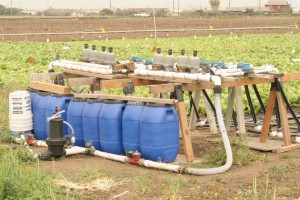Research Project: Determining the Fertilizer Value of Ambient Nitrogen in Irrigation Water – Cahn, M. et al.
Status: Final year of study

Manifold and injection system used for simulating irrigation water with different concentrations of nitrate-N.
Issue: Irrigation water from many wells on the Central Coast contains a significant amount of nitrate-nitrogen (NO3-N). The N content in irrigation water has not been accounted for in growers’ nitrogen fertilization plans because it is unclear how to reliably calculate the ‘fertilizer value’ of this N. Michael Cahn, Richard Smith and Tim Hartz began a study in 2013 to develop information and guidelines for utilizing ambient N in irrigation water for lettuce and broccoli, two of the primary crops in this region. Two trials focused on determining how well lettuce recovers N already present in irrigation water under various nitrate concentration and irrigation efficiency. The remaining trials examined the practical contribution of irrigation water N to crop fertility under a range of typical irrigation and N fertigation regimes.
Methods/Locations: These are field studies that are being carried out in Monterey County.
Main findings: Results to date have demonstrated that ambient N in irrigation water has fertilizer value for shallow rooted vegetable crops, such as lettuce, as well as deeper rooted vegetables, such as broccoli, even when the N concentration in the water was relatively low (12 ppm NO3-N). These results demonstrate that crop recovery of N from a water source has a similar recovery efficiency as a fertilizer source of N. These results were attained under a well-managed drip irrigation system, with a high distribution uniformity, irrigation efficiency and frequent irrigations (2 to 3 times per week), which likely minimized leaching losses, even under the high water application rate treatment. It is possible that under poor water management or less efficient irrigation methods (e.g. furrow), recovery of N would be less than was reported in these trials. However, potential reductions in crop N recovery caused by any of these scenarios would likely be similar for fertilizer N.
Potential Impact: Accounting for nitrate in irrigation water could significantly reduce total nitrate leaching to groundwater, not only in the Salinas Valley but statewide.
Link to Full Project Report: https://www.cdfa.ca.gov/is/docs/12-0455-SACahn.pdf


